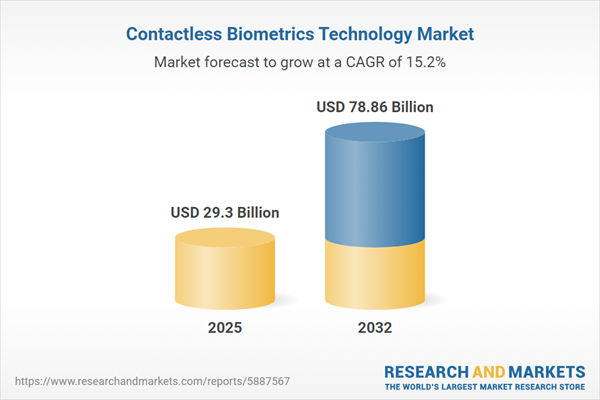Speak directly to the analyst to clarify any post sales queries you may have.
The contactless biometrics technology market is undergoing significant transformation as organizations modernize identity verification and access management processes to better safeguard digital assets and respond to regulatory requirements. As enterprises look to future-proof security frameworks, interest has intensified in touchless authentication that addresses user experience, operational continuity, and data privacy.
Market Snapshot: Contactless Biometrics Technology Market
The global contactless biometrics technology market has attained a value of USD 25.46 billion, with projected growth to USD 29.30 billion by 2025, representing a compound annual growth rate of 15.17%. Growth is spurred by accelerated digital transformation, as organizations prioritize secure and adaptable identification and authentication measures. Enterprises are investing in technology upgrades to mitigate rising security threats, streamline access management, and conform to new governance mandates. Adoption trends reveal a preference for integrated, user-friendly platforms that support regulatory compliance and align with evolving enterprise security strategies.
Scope & Segmentation of the Contactless Biometrics Technology Market
- Technology Modalities: Includes facial recognition with advanced 2D and 3D imaging, iris scanning for enhanced identification, voice authentication for seamless access, touchless fingerprint and palm recognition, and multimodal biometric systems to accommodate diverse security needs.
- System Components: Features imaging modules, high-resolution sensors, specialized cameras, and dedicated software platforms. These enable real-time analytics and pattern recognition aligned with stringent security protocols.
- Services: Spans consulting for technology selection, efficient deployment and integration, and continuous system maintenance to meet evolving IT and compliance challenges.
- End-User Industries: Embraced by sectors such as banking, government, healthcare, transportation, telecommunications, IT, and retail, where applications include payment security, citizen identification, and secure access management to align with industry-specific directives.
- Deployment Models: Offers both cloud-based and on-premise solutions, allowing customization to suit organizational infrastructure, location-based compliance, and scalability objectives.
- Regional Implementation: Adoption rates differ globally, with strong growth in North America, South America, and Asia Pacific, influenced by digital maturity and localized regulatory frameworks that drive deployment pace and configurations.
- Leading Companies: NEC Corporation, IDEMIA Group, Thales S.A., HID Global Corporation, Suprema Inc., Daon Inc., Aware Inc., Fingerprint Cards AB, NEXT Biometrics Group ASA, and Zwipe AS set industry benchmarks through security-focused and policy-compliant product offerings.
Key Takeaways for Senior Decision-Makers
- Integrating contactless biometrics streamlines digital identity management and helps reduce compliance risk within complex regulatory environments.
- Deploying advanced imaging and machine learning capabilities strengthens authentication resilience against emerging security threats.
- Building privacy-by-design into solutions supports multi-jurisdictional data governance and increases trust among stakeholders.
- Standardized interoperability frameworks aid smoother system integration, facilitate expansion across international markets, and enable rapid response to shifting regulatory demands.
- Customizable deployment options allow organizations to align biometrics with specific privacy standards, advancing risk management and supporting business growth initiatives.
Tariff Impact: U.S. Trade and Procurement Pressures
Recent U.S. tariff changes have increased procurement expenses for key biometric components. Organizations are responding with revised supply strategies, such as nearshoring and localized assembly, to reduce logistics risks and ensure stable operations. Strengthening partnerships with domestic technology vendors has become critical to timely delivery and operational stability amid ongoing trade policy changes.
Methodology & Data Sources
This report draws on executive-level interviews, regulatory expert consultations, direct end-user feedback, and targeted market analysis. Independent third-party reviews validate the findings, offering senior leadership a reliable information base for digital identity investment decisions.
Why This Report Matters
- Supports leadership in aligning biometrics investments with comprehensive compliance frameworks and forward-looking risk management practices.
- Clarifies sector and regional adoption dynamics so enterprises can refine planning and optimize solution deployment for maximum operational impact.
- Enhances navigation of complex regulatory landscapes, supporting the implementation of resilient business continuity strategies.
Conclusion
Contactless biometrics enables more robust identity management and streamlines access to meet the changing demands of compliance. Strategic adoption positions organizations to adapt confidently as security and regulatory priorities evolve.
Additional Product Information:
- Purchase of this report includes 1 year online access with quarterly updates.
- This report can be updated on request. Please contact our Customer Experience team using the Ask a Question widget on our website.
Table of Contents
3. Executive Summary
4. Market Overview
7. Cumulative Impact of Artificial Intelligence 2025
Companies Mentioned
The companies profiled in this Contactless Biometrics Technology market report include:- NEC Corporation
- IDEMIA Group
- Thales S.A.
- HID Global Corporation
- Suprema Inc.
- Daon Inc.
- Aware, Inc.
- Fingerprint Cards AB
- NEXT Biometrics Group ASA
- Zwipe AS
Table Information
| Report Attribute | Details |
|---|---|
| No. of Pages | 187 |
| Published | October 2025 |
| Forecast Period | 2025 - 2032 |
| Estimated Market Value ( USD | $ 29.3 Billion |
| Forecasted Market Value ( USD | $ 78.86 Billion |
| Compound Annual Growth Rate | 15.1% |
| Regions Covered | Global |
| No. of Companies Mentioned | 11 |









